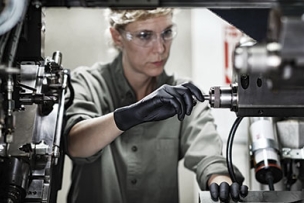Ansell is a global supplier of personal protection (PPE) equipment solutions designed for workers in a wide range of industries. Ansell's customers include businesses engaged in the Manufacturing, Agriculture, Healthcare and Scientific sectors, as well as many other business sectors. Ansell has developed a global presence that includes sales, operations and manufacturing sites in North America, Latin America, Europe and Asia and employs more than 15,000 people worldwide. Ansell's position as a market leader has evolved over more than 100 years of history and can be attributed to our history of providing innovative protection solutions to workers through a deep understanding of the worker experience.
Ensuring a sterile environment is crucial in various industries such as pharmaceuticals, biotechnology, and medical device manufacturing. Ansell’s range of cleanroom coveralls plays a vital role in maintaining these sterile conditions. This blog post will explore the differences between disposable and reusable cleanroom coveralls, the importance of aseptic donning, and the benefits of Ansell’s high-quality disposable coveralls.
DISPOSABLE VS. REUSABLE CLEANROOM COVERALLS
People are the biggest cause of contamination in cleanrooms. Therefore, it’s critical to wear the right coveralls to maintain cleanroom standards. When selecting cleanroom coveralls for life sciences applications, it’s important to recognize the fundamental differences between reusable and disposable coveralls to make an informed choice.
By selecting the appropriate garment for the application, employers can protect their valuable products and processes from harmful particles and ions. This improves product integrity and minimizes risk while protecting their workforce with appropriate PPE.
THE DIFFERENCE BETWEEN DISPOSABLE AND REUSABLE CLEANROOM COVERALLS

Material and Post-Processing:
- Disposable Coveralls: Typically feature a polyethylene film outer layer and a non-woven polypropylene inner layer, sterilized once by gamma irradiation without water usage in post-processing. This method maintains the integrity of the garment.
- Reusable Coveralls: Generally made of woven polyester, sterilized multiple times by gamma irradiation or autoclaving, and washed in deionized water. Repeated irradiation cycles can lead to the breakdown of garment fibers and degrade the fabric, causing it to relax and the pore size to become larger.

Bacterial Filtration Efficiency:
- Disposable Coveralls: Due to the laminated nature of the material, testing for bacterial filtration efficiency is not applicable.
- Reusable Coveralls: Initially show a bacterial filtration efficiency of less than 70%, which can drop to below 40% after several washes.

Chemical and Particle Protection:
- Disposable Coveralls: Offer TYPE 6 limited protection against liquid spray and splash, ensuring a barrier against chemical splashes. They also provide TYPE 5 protection against solid particulates. The design allows for comfort and flexibility during use while creating a solid barrier against skin particles, hair, lint, and other particles escaping from the garment.
- Reusable Coveralls: Do not offer effective protection against chemicals, as these substances can easily penetrate the garment, leading to contamination of the wearer.

Repairs and Rental Agreements:
- Disposable Coveralls: Require no repairs or rental agreements, offering a one-off payment system.
- Reusable Coveralls: Necessitate repairs for even minor damage and involve long-term rental contracts with fixed weekly costs, irrespective of garment usage.
BENEFITS OF DISPOSABLE CLEANROOM COVERALLS
Disposable cleanroom coveralls are crucial for minimizing cross-contamination and offering superior chemical protection. Classified as Class III PPE, they provide a flexible, no-commitment solution for adjusting quantities and sizes. They also come with consistent performance, physical characteristics, and recycling options, depending on your business or location.
UNDERSTANDING EU GMP ANNEX 1
The EU GMP Annex 1 guideline, updated on August 25, 2022, emphasizes quality risk management and contamination control in aseptic processing. It provides comprehensive guidance on maintaining sterility in medicinal product manufacturing.
THE IMPORTANCE OF ASEPTIC DONNING
Aseptic donning is crucial for maintaining sterility. Using Personal Protective Equipment (PPE) properly minimizes contamination risks during gowning. Adhering to specific protocols ensures the integrity and safety of both products and cleanroom environments.
ANSELL'S ASEPTIC DONNING METHOD
Ansell's aseptic donning method for cleanroom coveralls is a recommended approach to minimize contamination during the gowning process. Ansell's donning guides, available in static and video formats, show how to don cleanroom coveralls according to strict guidelines stipulated in Annex 1. Operators are only allowed to touch the inner surface of the cleanroom coverall when donning.









Talk to Us!
Leave a reply
Your email address will not be published. Required fields are marked *